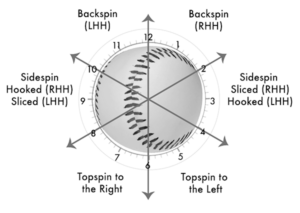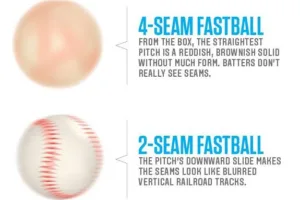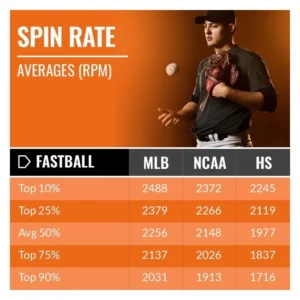 Spin rate is a crucial concept in baseball, particularly in pitching. It measures how many times a baseball spins after it is released by the pitcher, usually quantified in rotations per minute (RPM). A high spin rate can significantly influence the movement of the ball, making it harder for batters to hit. For instance, a fastball with a high spin rate tends to stay up in the strike zone, creating an illusion of rising as it approaches the plate. Conversely, a curveball with a high spin rate will drop more sharply, increasing its effectiveness. Understanding spin rate allows players and coaches to optimize pitching techniques and enhance performance on the field.
Spin rate is a crucial concept in baseball, particularly in pitching. It measures how many times a baseball spins after it is released by the pitcher, usually quantified in rotations per minute (RPM). A high spin rate can significantly influence the movement of the ball, making it harder for batters to hit. For instance, a fastball with a high spin rate tends to stay up in the strike zone, creating an illusion of rising as it approaches the plate. Conversely, a curveball with a high spin rate will drop more sharply, increasing its effectiveness. Understanding spin rate allows players and coaches to optimize pitching techniques and enhance performance on the field.
This article will delve into what spin rate means, its importance, and how it impacts the game. By exploring the different types of spin rates associated with various pitches, we will uncover how this metric can be leveraged to gain a competitive edge. Additionally, we will discuss the factors that influence spin rate, from physical mechanics and grip techniques to environmental conditions and equipment. Through case studies and expert insights, we will highlight real-world applications and the benefits of mastering spin rate in baseball. Whether you are a player, coach, or baseball enthusiast, this comprehensive guide aims to deepen your understanding of spin rate and its pivotal role in modern baseball.
Types and Categories
 Understanding spin rate involves examining how it varies across different types of pitches. Each pitch type has a unique spin profile that contributes to its effectiveness. Here, we will break down the spin rates for fastballs, curveballs, sliders, changeups, and other pitches, highlighting how these variations impact their movement and success in games.
Understanding spin rate involves examining how it varies across different types of pitches. Each pitch type has a unique spin profile that contributes to its effectiveness. Here, we will break down the spin rates for fastballs, curveballs, sliders, changeups, and other pitches, highlighting how these variations impact their movement and success in games.
- Fastball Spin Rate: Fastballs are often the cornerstone of a pitcher’s arsenal, and their effectiveness can be significantly influenced by spin rate. A higher spin rate on a fastball generally results in less downward movement, giving the pitch a "rising" appearance that can deceive hitters. This phenomenon, known as "hop," makes high-spin fastballs particularly challenging to hit. Conversely, fastballs with a lower spin rate tend to have more downward movement, making them easier for batters to track and hit. Understanding and optimizing the spin on a fastball can lead to more strikeouts and fewer home runs allowed.
- Curveball Spin Rate: Curveballs rely heavily on spin to generate their distinctive downward break. A curveball with a high spin rate will drop more sharply as it approaches the plate, creating a significant vertical movement that can fool batters. This sharp break is crucial for curveballs, as it makes them difficult for hitters to make solid contact. On the other hand, a curveball with a lower spin rate might not have as pronounced a break, reducing its effectiveness. Pitchers often work on increasing their curveball spin to enhance its dropping action and improve their overall pitching performance.
- Slider Spin Rate: Sliders' spin rate has a significant impact on their lateral movement, which is one of their defining characteristics. A high spin rate on a slider results in a sharper and more late-breaking horizontal movement, making the pitch harder for batters to anticipate and hit. This lateral break can be particularly effective when paired with a fastball, as it keeps hitters off balance. Sliders with lower spin rates may have less pronounced movement, making them easier for batters to connect with. By focusing on increasing the spin rate of their sliders, pitchers can add a deceptive and powerful weapon to their pitching repertoire.
- Changeup Spin Rate: Unlike fastballs, curveballs, and sliders, changeups typically have lower spin rates. The effectiveness of a changeup lies in its ability to mimic the appearance of a fastball while arriving at the plate at a slower speed. This speed differential can disrupt a batter’s timing, leading to weak contact or swings and misses. While a high spin rate is not as crucial for changeups, maintaining the appropriate spin rate helps in achieving the desired deception. Pitchers must balance spin and velocity to perfect their changeups and keep hitters guessing.
- Other Pitches Spin Rate: In addition to the primary pitches, other types of pitches like cutters, sinkers, and knuckleballs also have unique spin characteristics. Cutters, which are a variation of fastballs, benefit from a moderate spin rate to achieve their distinctive cutting action. Sinkers, on the other hand, typically have lower spin rates that result in a sinking movement, inducing ground balls. Knuckleballs are an exception, as they are thrown with minimal spin to create unpredictable movement. Understanding the spin rate for these and other less common pitches allows pitchers to refine their technique and maximize the effectiveness of their entire pitch arsenal.
By analyzing and optimizing the spin rates across various pitches, pitchers can enhance their performance, making their throws more deceptive and challenging for batters.
Diagnosis and Tests
 Understanding and measuring spin rate is essential for pitchers looking to optimize their performance. Accurate diagnosis and testing of spin rate provide valuable data that can be used to make informed adjustments to pitching mechanics. This section explores the tools available for measuring spin, how spin rate is utilized in practice settings, and its application in game situations.
Understanding and measuring spin rate is essential for pitchers looking to optimize their performance. Accurate diagnosis and testing of spin rate provide valuable data that can be used to make informed adjustments to pitching mechanics. This section explores the tools available for measuring spin, how spin rate is utilized in practice settings, and its application in game situations.
Tools for Measuring Spin Rate
Several advanced tools are available to measure spin rate with high precision. Devices like Rapsodo, Trackman, and high-speed cameras are commonly used in both professional and amateur baseball to capture detailed data on pitch spin rates. Rapsodo, for instance, uses radar technology to measure spin rate, spin axis, and other critical metrics. Trackman, another widely used tool, employs Doppler radar to track the baseball's trajectory and spin characteristics. High-speed cameras provide visual analysis, capturing the release point and ball rotation in slow motion. These tools collectively offer a comprehensive view of a pitch's spin dynamics, enabling coaches and players to analyze and improve their techniques.
Spin Rate in Practice
In practice settings, measuring spin rate allows pitchers to experiment with different grips, arm angles, and release techniques to optimize their pitches. Regular monitoring of spin during bullpen sessions helps pitchers understand the immediate impact of mechanical changes. For example, a pitcher working on a new grip for a curveball can use spin rate data to determine if the grip adjustment leads to increased spin and sharper break. Coaches can use this data to provide immediate feedback and tailor training programs to address specific needs. By integrating spin rate measurements into routine practice, pitchers can make incremental improvements that lead to significant performance gains over time.
Spin Rate in Game Situations
Measuring spin rate in game situations provides real-time data on how pitches perform under competitive conditions. This data is crucial for making strategic adjustments during a game. For instance, if a pitcher’s spin rate drops during a game, it could indicate fatigue or mechanical issues that need to be addressed. Conversely, identifying pitches with consistently high spin can inform game strategy, such as which pitches to rely on in critical situations. Additionally, understanding spin rate trends over multiple games can help in long-term planning and development. Advanced analytics teams in Major League Baseball (MLB) often use spin rate data to scout opponents and devise pitching strategies that exploit batters’ weaknesses.
In conclusion, accurate measurement and analysis of spin are vital for diagnosing and improving pitching performance. The use of sophisticated tools like Rapsodo and Trackman in both practice and game settings provides valuable insights that can enhance a pitcher’s effectiveness. By continuously monitoring and adjusting based on spin rate data, pitchers can develop more effective pitches, improve their overall performance, and gain a competitive edge on the mound.
The Science of Spin Rate and Biomechanical Drivers
 The spin rate of a baseball is a critical factor in determining the effectiveness and movement of a pitch. Understanding the biomechanics behind spin rate is essential for pitchers aiming to optimize their performance. A study by Keeley, Wicke, Alford, and Oliver (2010) provides valuable insights into the relationship between forearm pronation and ball movement for two primary fastball variations: the two-seam and four-seam fastballs.
The spin rate of a baseball is a critical factor in determining the effectiveness and movement of a pitch. Understanding the biomechanics behind spin rate is essential for pitchers aiming to optimize their performance. A study by Keeley, Wicke, Alford, and Oliver (2010) provides valuable insights into the relationship between forearm pronation and ball movement for two primary fastball variations: the two-seam and four-seam fastballs.
Biomechanics of Forearm Pronation
Forearm pronation, the rotational movement of the forearm that turns the palm downward, plays a significant role in generating spin on a baseball. The study by Keeley et al. (2010) quantified forearm pronation angles and their acceleration leading up to and through ball release. It was observed that the forearm remains in a pronated position throughout the pitching motion, maintaining an angle near 140° for both two-seam and four-seam fastballs. This consistent pronation angle indicates that pitchers use similar mechanics across these two fastball variations, likely due to coaching techniques that emphasize uniformity in pitching mechanics.
Kinematic Similarities and Pitching Techniques
The study highlighted that the forearm kinematics for both fastball variations were remarkably similar, with no significant differences observed in pronation angles or acceleration patterns. This similarity can be attributed to the common coaching strategy of promoting consistent mechanics across different pitch types. Such an approach allows pitchers to disguise their pitches better, making it harder for batters to predict the type of pitch being thrown based on the pitcher's arm motion.
Relationship Between Pronation Acceleration and Ball Movement
One of the critical findings of the study was the significant positive correlation between pronation acceleration at the moment of release and the magnitude of vertical ball movement. This correlation suggests that faster pronation at release results in greater vertical deviation of the pitch, enhancing its effectiveness. Specifically, the study found that 34% of the variance in the vertical deviation of fastballs could be explained by the rate of pronation acceleration at release. This finding underscores the importance of forearm pronation in generating effective spin and movement on the ball.
Tactical Advantages of Late Kinematic Alterations
The study also supports the idea that kinematic alterations in the pitching motion should occur late in the pitch cycle. Making adjustments to forearm kinematics just before and at the moment of release can help pitchers disguise their pitches, giving batters less time to react. This tactical advantage can be crucial in higher levels of play, where the ability to deceive the batter can significantly impact the outcome of the at-bat.
In summary, the study by Keeley et al. (2010) provides valuable insights into the biomechanical drivers of spin, particularly forearm pronation. Understanding these mechanics can help pitchers optimize their spin rates, improve their pitch effectiveness, and gain a competitive edge on the mound. By focusing on the acceleration of forearm pronation at release, pitchers can enhance the vertical movement of their fastballs and better disguise their pitches, making them more challenging for batters to hit.
Enhancing Pronation Acceleration with the Trunk Accelerator
 The Trunk Accelerator is an innovative tool designed to train the kinetic chain effectively, enhancing pronation acceleration for pitchers. One of the common issues pitchers face is the premature opening of the trunk, often referred to as "flying open." This flaw in mechanics can cause arm drag, leading to delayed pronation and reduced pitch effectiveness. The Trunk Accelerator addresses this issue by ensuring proper timing and coordination throughout the pitching motion.
The Trunk Accelerator is an innovative tool designed to train the kinetic chain effectively, enhancing pronation acceleration for pitchers. One of the common issues pitchers face is the premature opening of the trunk, often referred to as "flying open." This flaw in mechanics can cause arm drag, leading to delayed pronation and reduced pitch effectiveness. The Trunk Accelerator addresses this issue by ensuring proper timing and coordination throughout the pitching motion.
How the Trunk Accelerator Works
The Trunk Accelerator helps pitchers maintain proper alignment and sequence in their pitching mechanics. By focusing on the trunk's movement, it ensures that the shoulders and hips remain synchronized, preventing premature opening. This synchronization is crucial for transferring energy efficiently from the lower body through the trunk to the arm, ultimately enhancing the acceleration of forearm pronation.
When the trunk opens too early, it disrupts the kinetic chain, causing the arm to lag behind. This arm drag delays pronation, reducing the spin rate and effectiveness of the pitch. The Trunk Accelerator trains pitchers to keep their trunk closed longer, allowing the arm to catch up and pronate at the correct moment. This timing is essential for maximizing spin and pitch movement.
Benefits of Using the Trunk Accelerator
Using the Trunk Accelerator can lead to several key improvements in a pitcher’s performance:
- Enhanced Pronation Acceleration: By preventing the trunk from flying open, the Trunk Accelerator allows pitchers to achieve faster and more efficient pronation, resulting in higher spin rates and better pitch movement.
- Improved Kinetic Chain Efficiency: The tool promotes proper sequencing of the pitching motion, ensuring that energy is transferred effectively from the legs through the trunk to the arm. This results in more powerful and consistent pitches.
- Reduced Risk of Injury: Maintaining proper mechanics reduces the strain on the arm and shoulder, lowering the risk of injuries commonly associated with poor pitching mechanics.
- Consistent Pitching Mechanics: Regular use of the Trunk Accelerator helps pitchers develop muscle memory for correct mechanics, leading to more consistent and reliable performance on the mound.
Enhance your pitching performance and achieve better pronation acceleration with the Trunk Accelerator. By training your kinetic chain effectively, you can improve your spin, reduce injury risk, and maintain consistent mechanics. Invest in your future as a pitcher and take your game to the next level. Visit TopVelocity to purchase the Trunk Accelerator today!
For more exclusive content visit the TopVelocity Patreon!




